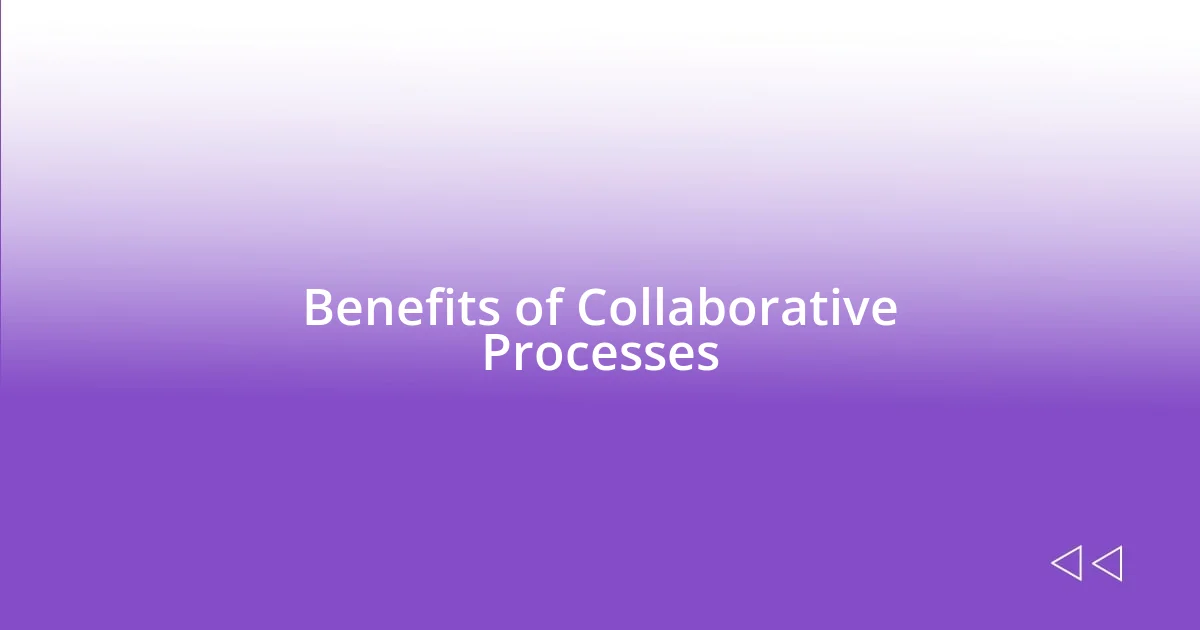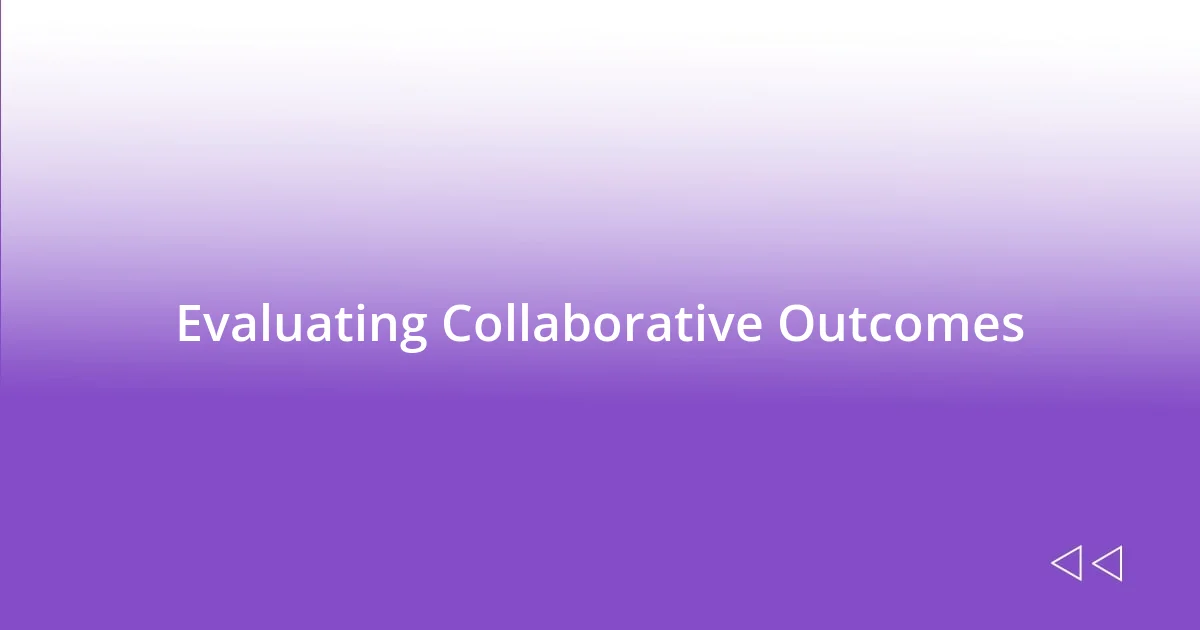Key takeaways:
- Collaborative creativity thrives on diverse perspectives, trust, and open communication, enhancing both team dynamics and innovative solutions.
- Engaging in regular feedback and celebrating small wins fosters motivation and strengthens team relationships, leading to more effective collaboration.
- Addressing conflicts directly and embracing vulnerability within teams can transform challenges into opportunities for growth and creativity.

Understanding Collaborative Creativity
Collaborative creativity is more than just working together; it’s about weaving our individual ideas into a vibrant tapestry. I still remember when I joined a brainstorming session where everyone was encouraged to share even the wildest ideas. What surprised me was how a seemingly silly suggestion ended up being the springboard for something truly innovative. Isn’t it fascinating how one person’s outlandish thought can inspire a breakthrough?
In working with diverse groups, I’ve found that understanding each member’s strengths is crucial. One time, in a project with a mix of artists and engineers, we discovered that combining analytical thinking with creative flair led to solutions that neither party could have developed alone. This melding of perspectives not only enhanced our end product but also fostered a deep sense of respect and teamwork among us. How often do we really tap into the unique talents of those around us?
When we engage in collaborative creativity, we’re not just merging ideas; we’re experiencing the joy of synergy. I often think about how our conversations flow when we embrace vulnerability and openness. By sharing our fears and excitement, we create an emotional connection that enriches the creative process. What if every collaboration felt like an adventure—where each twist and turn brought us closer to something unexpected and beautiful?

Benefits of Collaborative Processes
Collaborative processes bring a multitude of benefits that can significantly enhance creativity and innovation. From my experience, one of the standout advantages is the variety of perspectives that emerge. When I’ve worked with a team of diverse individuals, each member approaches problems with their unique lens, enriching the discussion. It’s like mixing different colors on a palette; the combination often produces striking results that we wouldn’t have reached alone.
I’ve also noticed a delightful increase in motivation when collaborating. In a recent project, I was paired with a group that initially felt daunting. However, as we bounced ideas off one another, I found ourselves building each other’s enthusiasm. The excitement became contagious, fueling our creative energy and pushing us to explore beyond our comfort zones. It’s amazing how supportive encouragement can transform a daunting task into something exhilarating and fun.
Moreover, collaborative processes often result in improved problem-solving capabilities. I remember a time when our team faced a particularly stubborn challenge. Instead of getting stuck, we held a quick roundtable discussion where each person contributed thoughts without judgment. To my surprise, the solutions that emerged were inventive and pragmatic. This experience reinforced my belief that two (or more) heads are indeed better than one when it comes to tackling complex issues.
| Benefit | Description |
|---|---|
| Diverse Perspectives | Enriching discussions by pooling different ideas and approaches. |
| Increased Motivation | Boosting enthusiasm through shared support and encouragement. |
| Enhanced Problem-Solving | Improving creativity and solutions through collaborative brainstorming. |

Key Principles of Collaboration
Collaboration thrives on trust and communication. I’ve been in teams where open dialogue was encouraged, and it transformed our dynamics completely. I remember a project where we adopted a “no idea is a bad idea” policy, which led to incredible breakthroughs. It was refreshing to see team members free to express themselves, knowing they wouldn’t be judged. This atmosphere made all the difference, fostering creativity that may have remained dormant in a more restrictive setting.
- Trust: Building mutual respect creates a safe space for sharing ideas.
- Active Listening: Engaging fully with others’ thoughts can spark unexpected connections.
- Inclusivity: Ensuring everyone feels valued leads to richer collaboration and innovation.
It’s also important to embrace flexibility in our collaborative efforts. In my experience, the best ideas often come from adapting to shifting perspectives. I once worked on a project that started with a rigid plan, but as we shared our evolving insights, we found ourselves going in a completely different—yet more rewarding—direction. This fluidity allowed us to approach challenges from various angles and led to a solution that was not only effective but also innovative.
- Flexibility: Being open to change fosters creativity and allows ideas to grow.
- Shared Goals: Aligning on objectives helps unify the team’s direction.
- Constructive Feedback: Providing and receiving feedback is vital for continuous improvement and collaboration.

Effective Communication Techniques
Effective communication is at the heart of any successful collaborative creative process. I’ve often found that using clear, concise language helps avoid misunderstandings. For instance, during a recent workshop, I noticed how explaining concepts in simple terms sparked more engagement. It made everyone feel included, and suddenly, ideas flowed freely as we built on each other’s contributions.
Listening is equally crucial; it’s more than just hearing words. In my experience, active listening—where you truly focus on what someone is saying without planning your response while they’re talking—can lead to remarkable insights. I recall a brainstorming session where one team member mentioned an idea almost in passing. Rather than moving on, I asked them to elaborate, and it opened a whole new avenue for our project that none of us had considered before. It was a great reminder: sometimes the gems lie buried within the quieter voices.
Lastly, regular check-ins can significantly enhance communication dynamics. I’ve worked on teams where we implemented brief daily huddles. Sharing our progress and challenges not only kept everyone in the loop, but it also fostered a sense of accountability. Reflecting on those moments makes me realize how vital it is to celebrate small wins together. Nothing boosts morale like acknowledging progress as a collective!

Tools for Collaborative Creativity
Tools for fostering collaborative creativity are diverse and can significantly shape the outcome of group efforts. One tool that I have found invaluable is digital brainstorming platforms, such as Miro or Trello. In a recent project, we used Miro to visualize our ideas, and it was astonishing to see how a simple board could ignite everyone’s enthusiasm. As we dragged and dropped notes, connections started forming, and the creative energy became palpable. Have you ever tried visual tools? They can turn abstract thoughts into tangible concepts.
Another remarkable resource I recommend is collaborative document editing tools like Google Docs. During a tight deadline project, my team used shared documents to iterate on ideas in real time. I still remember the excitement—watching my colleagues’ ideas populate the page as we engaged in a lively debate about the best direction to take. It transformed a potentially stressful situation into a collective brainstorming session that felt not only productive but also enjoyable. Isn’t it empowering to see everyone’s thoughts flowing together?
Lastly, I can’t emphasize enough the role of regular feedback sessions, perhaps facilitated through tools like Slack or Microsoft Teams. In one of my past experiences, we set aside time every week to give each other constructive feedback on ongoing projects. I discovered that these sessions didn’t just refine our work but also deepened our relationships as team members. Wouldn’t you agree that sharing insights regularly strengthens bonds? Those moments of vulnerability and support turned our group into a more cohesive unit, genuinely invested in each other’s success.

Overcoming Common Challenges
In any collaborative creative process, conflicts and differing opinions can arise, but I’ve learned that addressing them head-on can be transformative. Once, in a cross-functional team, tensions bubbled over regarding project priorities. Instead of avoiding the discomfort, we held a candid discussion where everyone shared their perspectives. This openness not only clarified our different goals but also fostered mutual respect, ultimately aligning us towards a common vision. When have you faced conflicts in teamwork, and how did you resolve them?
Time management is another hurdle that can easily derail collaboration. I’ve found that setting clear timelines helps to keep everyone accountable and focused. During a group project last year, we had a daunting deadline looming. I initiated a visual timeline where everyone could see each other’s contributions and responsibilities. It created a palpable urgency that motivated us and, as we crossed off tasks together, the collective satisfaction was immense. It’s powerful how a little structure can transform chaos into harmony, isn’t it?
Lastly, embracing vulnerability can be an incredible asset in overcoming challenges. I used to shy away from sharing my hesitations, fearing it would make me seem incapable. However, during a recent collaborative effort, I revealed my uncertainties to the team. To my surprise, others echoed my feelings, leading to a rich discussion that not only nurtured trust but also uncovered solutions we hadn’t considered. Don’t you think that by being open about our struggles, we not only strengthen bonds but also enhance the creative process?

Evaluating Collaborative Outcomes
Evaluating collaborative outcomes goes beyond just assessing the final product; it requires introspection into the dynamics of the group itself. I remember a project where we developed a community arts initiative, and when we reviewed our progress, we didn’t just look at the end result. We reflected on our interactions, the spirit of collaboration, and how individual contributions complemented each other. This deeper exploration illuminated strengths we hadn’t initially recognized within our team. Have you ever taken a moment to evaluate not just what you created, but how you created it?
One of the most impactful ways to evaluate outcomes is through soliciting feedback from all team members. During a particular project, I initiated a feedback loop by asking open-ended questions, inviting everyone to share not only what worked but also what didn’t. Surprisingly, those conversations revealed insights that shifted our thinking entirely. It felt refreshing to realize that constructive criticism could spark creativity rather than stifle it. Have you tried harnessing feedback to fuel ongoing projects? It can be a game-changer.
Lastly, I’ve found that celebrating wins—both big and small—forms an essential part of evaluating collaborative efforts. In a recent initiative, after we successfully launched a community event, we took the time to gather and celebrate our accomplishments. Sharing stories of personal growth and newfound skills made that moment not just a reflection of success, but also an affirmation of our collective journey. It’s remarkable how recognizing each other’s contributions can strengthen the group’s future efforts. Don’t you think that these celebrations can foster an even stronger team spirit moving forward?














